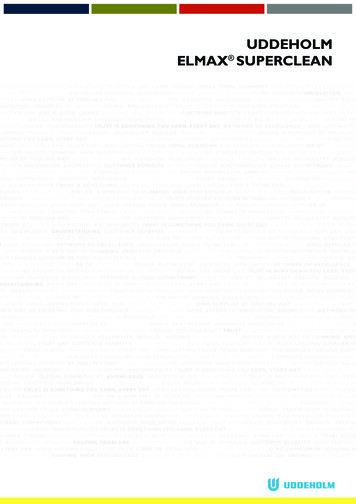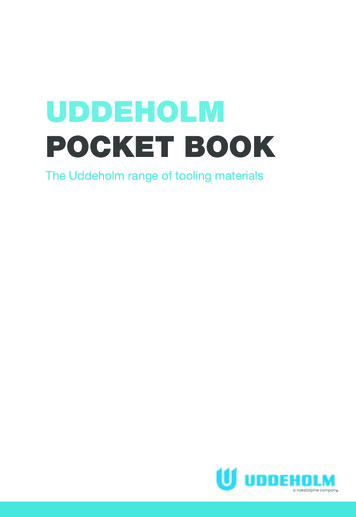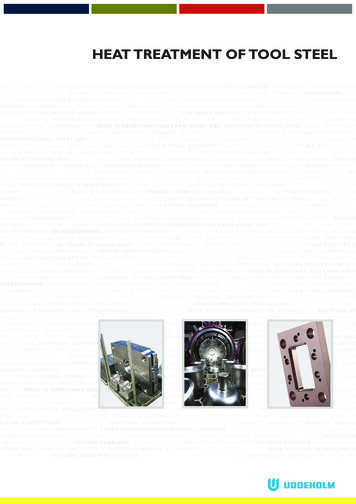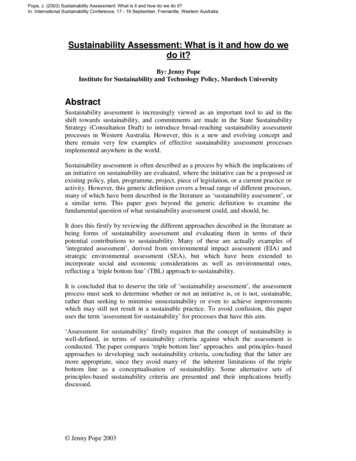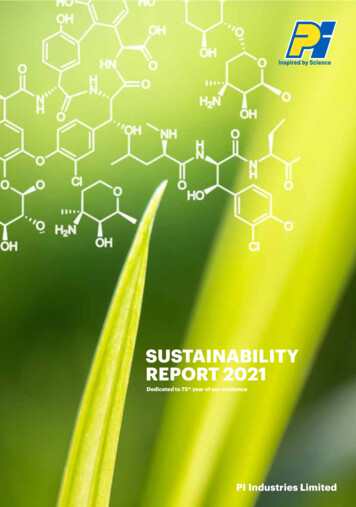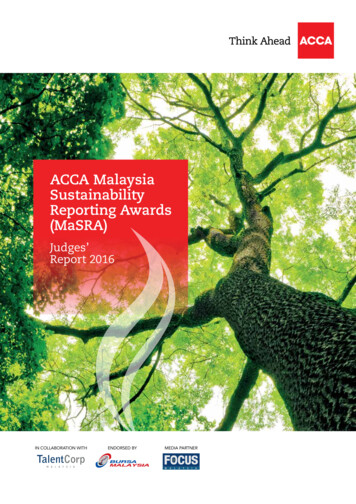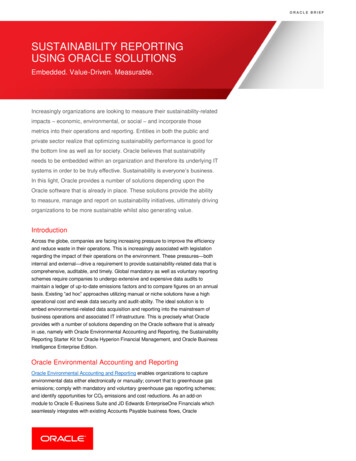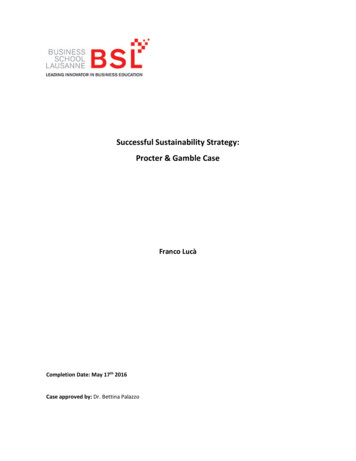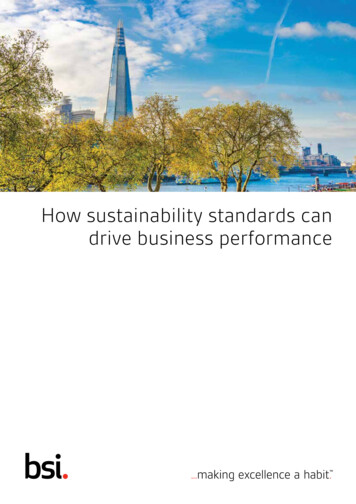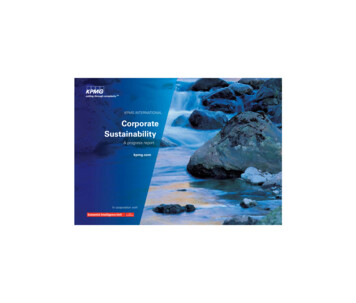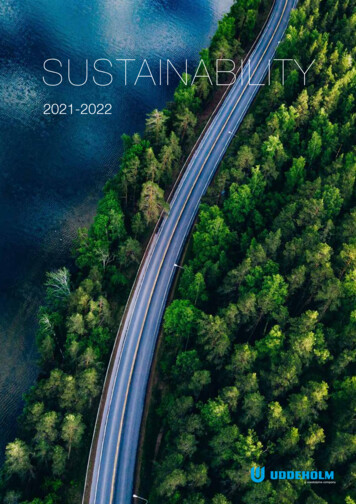
Transcription
SUSTAINABILITY2021-2022
ustainable development is a principle that seeks to satisfyfundamental human rights and opportunities for human development while maintaining the ability of natural systems to providecommunities and people with natural resources and ecosystemservices.This report is printed on paper made from 100% recycled materialSustainability report Uddeholm 2021/2022Fossil-free production and climate neutrality90% reduction in fossil CO2 emissions100% of Uddeholm’s cooling water is returned to the natural cycle100% fossil-free electricityWinner of the 2022 Sustainability AwardVision & StrategyThe Uddeholm company4681012141618EnvironmentUddeholm’s fossil CO2 emissions from the manufacturing processAreas of focus in the pursuit of climate neutralityThe pursuit of fossil-free transportHigh share of recycled materials in Uddeholm’s productsUddeholm’s focus on resource efficiencyInterview with Ola OhlssonCircular economySustainable supply chainInterview with Örjan AlmWater use at UddeholmEnergy use at UddeholmOur competitive advantage – fossil-free electricityUddeholm’s significant environmental aspectsClimate change – prevention work202425262829313235363840444850The employeeUddeholm’s values – the foundation on which the organisation restsLong-term work for a sustainable workplaceParental leaveInterview with Emma Mellgren – employee in the production ESR200 different job roles at Uddeholm in HagforsRecruitmentInvestment in skills – maintain and further developSafety at UddeholmSafe chemical handlingRisk work at Uddeholm5254565860636466687374The BusinessUddeholm business policyCompliance767779ProductionTo ensure disturbance-free manufacturing in all our processesThe production systemSteel production in SwedenUddeholm’s Climate Week – a reduction of CO2 by up to 90%8081818285The product86Local collaboration and strong local roots88Appendix 1 Environmental, Economic and Social Sustainability at UddeholmAppendix 2 The UN’s global goalsAppendix 3 The Paris Agreement, The Green Deal & Climate goals for Sweden9091943
Sustainability report Uddeholm 2021/2022Sustainability is not a new concept for us. Since the 1960s we’ve used an electric arc furnace in the smeltingprocess at our steelworks. We have reduced our fossil CO2 emissions by 46% since 1990. We are already usingonly 100% fossil-free electricity and our products are made from 84-98% recycled material. We are convincedthat new technological innovations will play an important role in many of the global environmental challenges. Ourexperience, our expertise and our values will be the key to further development.At Uddeholm, we have already started the journey to fossil-free production and climate neutrality. Our productionsystem and location provide us with very well suited conditions for leading this development. By 2030 we will havefossil-free production and by 2040 the entire lifecycle of our products will be climate-neutral.In 2021, we carried out a climate-neutral production week. During Uddeholm's Climate Neutral week, we replacedLNG (Liquefied Natural Gas) with fossil-free LBG (Liquefied Bio Gas). All internal transports also switched over tofossil-free electricity or 100% HVO100 (Biodiesel). These measures will lead to a significant reduction of up to 90%of our fossil CO2 emissions. These are real changes. Changes that show that what might be considered impossible is actually possible. Not tomorrow, but today.Over the year we carried out activities to strengthen our work environment, which should be safe and healthy. Ourbusiness must be conducted in a way where no one gets hurt at work and where we care about each other'ssafety. In addition, we work preventively with our physical and mental health. A health policy has been developedand is continually revised to meet the standards required for a sustainable and healthy work environment.Together, our network of experts around the world work non-stop to create solutions that are sustainable, secureand long-lasting – for our customers and for ourselves. In other words, our customers get much more from usthan just steel. They also get our promise to always produce steel that is as kind on the environment as possible.Achieving this is an ongoing process and a promise that must be kept every day.Uddeholm, June 2022CEOs Johan Wiig and Pär EmanuelssonThis sustainability report is simplified and we will be referring to the Group's overall sustainability report.45
FOSSIL-FREE PRODUCTION ANDCLIMATE NEUTRALITYUddeholm has started the journey of manufacturing and delivering climate-neutral toolsteel already. Our production system and location provide us with very well suited conditions for leading this development. We divide this goal into three steps:1. Fossil-free production and a clearly reduced fossil footprint in our distribution by20302. Climate-neutral value chain by 20353. Climate-neutral lifecycle by 204067
90% REDUCTION INFOSSIL CO2 EMISSIONSSustainability has long been an important key factor for Uddeholm. Years of research and development have put us at theforefront of sustainable tool steel manufacturing. Despite variouschallenges, it is now time for the next step. At the end of 2021,we carried out a week-long test, producing climate-neutral toolsteel to show that the impossible is possible. The week resultedin a reduction of up to 90% of Uddeholm's fossil CO2 emissions.3 steps to achieving climate-neutral tool steelStep 1 – Start with a solid foundationSustainability is not a new concept for us. Since the 1960s we’ve used an electric arcfurnace in the smelting process at our steelworks. We have reduced our fossil CO2emissions by 46% since 1990. We are already using only 100% fossil-free electricityand our products are made from 84-98% recycled material.Step 2 – Make real changesThroughout Climate Neutral Week, we replaced LNG (Liquefied Natural Gas) with fossil-free LBG (Liquefied Bio Gas). All internal transports also switched over to fossil-freeelectricity or 100% HVO100 (Biodiesel). These measures will lead to a significantreduction of up to 90% of our fossil CO2 emissions.Step 3 – Climate compensationThe remaining 10% of our emissions consist of carbon in scrap metal, graphiteelectrodes and alloys used for the smelting process in the electric arc furnace (EAF).No fossil-free substitutes exist for these as yet. Therefore, this last 10% is compensated through certificates in accordance with the Gold Standard that meet the UN'ssustainability goals.89
100% OFUDDEHOLM’SCOOLING WATERIS RETURNED TOTHE NATURALCYCLEIn 2021, Uddeholm borrowed 11 million cubicmetres of water to cool our processes. Over80% of the water is borrowed and returned,having had no direct contact with Uddeholm'sproduction processes.The remaining amount undergoes purificationbefore being returned to Lake Värmullen. Before we return the water, we test it carefully.Over 30 water samples are taken every day.These are sent for analysis on a weekly basisand then matched against flow to verify bothconcentration levels and total amounts.1011
100%FOSSIL-FREEELECTRICITYThe types of energy used by Uddeholm today are electricity, LPG,natural gas and district heating. It is important to have a balancebetween the types of energy, something that is also taken intoaccount in the forthcoming Climate and Energy Roadmap and thepursuit of fossil freedom. The electricity and most of the districtheating today comes from fossil-free sources. The natural gas andthe smaller amount of LPG are of fossil origin, which we strive tominimise, seeking to replace these completely over time.The electricity mix delivered to Uddeholm is from Nordic powerplants and is 100% fossil-free. About 55% of Uddeholm's energyuse in 2021 consisted of electricity. Uddeholm's existing electricity mix consists of nuclear power (51.2%), hydropower (46.3%),wind and solar (2.5%). About 49% is renewable energy. Electricitywithout fossil origins is a unique advantage for Sweden/the Nordiccountries.1213
WINNER OF THE 2022SUSTAINABILITY AWARDUddeholm has received this year’s Sustainability Award at the Schaeffler Supplier Day. The event took place atSchaeffler Headquarters with guests from over 50 suppliers. Furthermore, it has been live streamed to additional700 participants worldwide.Schaeffler is very impressed by the pace and targets of Uddeholm when it comes to sustainability. Not only CO2emissions but also when it comes to water use, diversity, etc. It is very much in line with their supply chain strategy.Max Odernheimer, Head of Strategic Marketing, Uddeholm Germany, received the award at the event.1415
Vision & StrategyAt Uddeholm we are shaping the world. We are shaping the world in partnershipwith the global manufacturing industry – now and for generations to come.The vision reflects our goals and our values, and shows the way forward for us as an organisation. We at Uddeholm manufacture steel that shapes the products surrounding us in our everyday lives. We shape the world andwe want to shape it in a sustainable way that is fair to both humanity and the environment. In this way, we cancontinue to shape the world, today and for future generations. The vision will communicate with us employees atUddeholm, with our sales companies, our customers and also the rest of the world.Uddeholm has a company-wide strategy that is broken down into five parts: Environmental strategyEmployee strategyBusiness strategyProduct strategyProduction strategyIn the next step, these parts are broken down into strategic plans with activities set out for each part of the organisation, allowing them to contribute to Uddeholm’s success in achieving the overall corporate strategy. Thebusiness, product and production strategies will only be presented in brief, given that in their entirety these wouldcontain information that is not to be distributed outside of the company. Other strategies are presented in moredetail.1617
The Uddeholm companyUddeholm is a world leader in developing, manufacturing and marketing of high-quality tool steels forindustrial tools. Millions of products are manufactured using the tools every year. Our end consumers arespread over most industries. Products such as cars, TVs, computers, mobile phones and white goodsall have their origins in tool steel. More than 100,000 customers in over 90 countries buy tool steel fromUddeholm. Uddeholm's history is more than 350 years long. The business was established in Hagfors in1878 thanks to a fortunate ecosystem: the availability of cold water from Uvån under its own pressure.Since 2007, Uddeholm has been part of the internationally listed steel group voestalpine AG, headquartered in Linz, Austria, with approximately 50,000 employees. The Hagfors production facility employs850 people.1819
EnvironmentThe global environment is everyone's responsibility. We will do what we can to minimise our footprint within ourgeneration. As such, our steel production and operations will have long-term climate-positive effects so that wedo not affect our local environment in a negative way. We will take on our responsibility to drive the developmentof a more sustainable steel and manufacturing industry. Through our environmentally leading operations based ona circular re-use and sustainable lifecycle for our products, Uddeholm will be an obvious choice for the growingnumber of environmentally conscious customers.84-98% RECYCLEDMATERIALSAt Uddeholm we have come a long way in sustainability, both economically, socially and environmentally. If welook, for example, at the environmental aspect, that journey began several decades ago. Uddeholm's arc furnacewas commissioned in the early 1960s. A direct result of the arc furnace was that energy consumption decreasedby 80%, calculated in kWh per tonne of steel produced, compared with ore-based production.Uddeholm has worked for decades on a long-term plan to reduce fossil CO2 emissions. Since the base year1990, Uddeholm's fossil CO2 emissions have decreased by more than 46%. But the journey does not stop there,even if it may be more challenging and demanding at this point, as Uddeholm today has low levels of fossil CO2emissions. Uddeholm will continue to work actively to reduce fossil emissions by 3,100 tonnes of CO2 per year.By 2030, Uddeholm will be down to zero for fossil CO2 emissions.100% FOSSIL-FREEELECTRICITYCO2 emissions per tonne of steel produced0,8Uddeholm’s products consist of up to84-98% recycled materialsUddeholm's electricity mix comes from Nordicpower plants with no fossil sources0,70,60,550% FOSSIL-FREETRANSPORT100% COOLING WATERRETURN0,40,30,20,1Over 50% of Uddeholm's internal transport isfossil-free and consists of fossil-free electricityor renewable fuel20100% of Uddeholm’s cooling water isreturned to the natural 282029203021
2030We will be the first in the world to manufacture a climate-neutral tool steelScope 3 IndirectScope 2 IndirectScope 1 DirectScope 3 IndirectWe have already begun the journey towards producing a climate-neutral tool steel. Our production system andlocation provide us with very well suited conditions for leading the development of climate-neutral steel.We divide this goal into three steps: Step 1: Fossil-free production and a clearly reduced fossil footprint in our distribution by 2030Step 2: Climate-neutral value chain by 2035Step 3: Climate-neutral lifecycle by 2040By 2026/27, we will therefore: Every year, carry out energy efficiency projects corresponding to at least 3% of energy use, of which at leasthalf come from fossil sourcesReduce fossil emissions by 3,100 tonnes of CO2 per yearOn this journey it is important to be aware of the entire value chain, from raw material extraction to when a productcomes to the end of its use and must be discarded. To help us in our work, we have chosen to call on the GHGprotocol and its definitions for the parts of a lifecycle, as named in the scopes. 2035Scope 1, which refers to direct emissions from the company's own facilities.Scope 2, which refers to emissions from purchased electricity and heat.Scope 3 covers indirect greenhouse gas emissions, in addition to purchased energy, that occur outside of thebusiness's boundaries.The greenhouse gas emissions in Scope 3 are divided into so-called upstream and downstream greenhouse gasemissions, depending on whether they occur before or after our own operations in the chain.What does climate neutrality mean to us?Climate-neutral means that no impact on the climate is caused, i.e. net-zero emissions. That there is abalance between carbon dioxide emissions and the absorption of carbon dioxide from the atmosphereinto carbon dioxide sinks.Definition through these scopes has been a baseline in our strategy work, but when we come to implementation measures, we choose not to follow the scopes as fixed steps but divide up the work inline with our ability to influence the outcome. Below are Uddeholm's steps towards climate-neutralproduction.20402030 – Fossil-free production and a clearly reduced fossil footprint in our distribution by 2030. From gateto gate.Net zero CO2 emissions at Uddeholm's facility in Hagfors (Scopes 1 & 2): 2035 – Climate-neutral value chain by 2035. From cradle to gate.Net zero CO2 emissions from the purchase of raw materials until a finished product leaves the operations in Hagfors. (Scopes 1, 2 and downstream part of 3): Climate compensation for remaining fossil CO2 emissionsIncreased demands on suppliers2040 – Climate-neutral lifecycle by 2040 From cradle to grave/cradle. 22Electrification and use of fossil-free fuel in business furnaces (e.g. biogas/hydrogen)Use of fossil-free coal in the Steelworks where possibleClimate compensation for remaining fossil CO2 emissionsNet zero CO2 climate footprint throughout the lifecycle from raw material to final product (scopes 1-3)23
Uddeholm's fossil CO2 emissions from the manufacturing processUddeholm has the advantage of using scrap as a raw material – CO2 emissions from scrap-based steel productionare less than one tenth of those generated in connection with iron ore-based steel production. In addition, theenergy requirement is only one-fifth compared with ore-based steel production.Achieving Uddeholm's high level of product quality, which provides longer service life and higher performance,requires more heating and heat treatment. This process involves the combustion of energy and accounts for about94% of our CO2 emissions. Natural gas and biogas are used in many of our furnaces for heating and heat treatment. LPG is used in smaller quantities in, for example, ladle preheating. The remaining 6% of Uddeholm's CO2emissions come from the consumption of raw materials in the steelworks.Areas of focus in the pursuit of climate neutralityUddeholm's main activities 2021/22-2,700 TONNES FOSSIL CO2-600 TONNES FOSSIL CO2Replacement projects and process controlof furnaces resulted in a saving of 16 GWh– a reduction of 2,700 tonnes of fossil CO2emissionsA natural gas furnace converted to electricity,which led to a reduction of 600 tonnes of CO2and 1 tonne of NOx (1% of NOx emissions in2020)-1,044 TONNES FOSSIL CO2REUSE OF WASTE PRODUCTSOne week of production with Biogas, insteadof Natural Gas, resulted in a reduction of1044 tonnes of CO2Today, none of Uddeholm's residual productsgo to landfill, but are reused as raw orconstruction materialsUddeholm is a participant in the EU's emissions trading (EU ETS) and has a good system for monitoring the business's CO2 emissions.CO2 from Uddeholm's production, Scope 1-2The types of energy that Uddeholm currently uses are mainly electricity and natural gas, and to a limited extentLPG and district heating for on-premises heating. For strategic reasons, Uddeholm has opted to use several typesof energy as a basis for minimising risks linked to supply and price.Natural gas currently generates the majority of Uddeholm's CO2 emissions. If upgraded biogas were availableat a realistic price and in the right volume we could replace 94% of direct emissions with green CO2 as naturalgas and biogas flow in the same energy system. Today, it is not realistic to have a full-scale transition but is animportant activity and so we intend to increase the proportion of biogas. Electrifying furnaces is also an option asUddeholm's electricity is CO2 free.When it comes to eliminating the proportion of CO2 from raw materials, 6%, it is not as obvious. There are no alternatives today but several research projects are ongoing. We are active in this area – and it is so important that wefocus at all stages on sustainable solutions, which then includes raw materials with good quality and functionality.Internal transport accounts for about 2% of total fossil CO2 for all operations in Hagfors. Today, these are over 50%fossil-free thanks to electric power via CO2-free electricity and 42% blending of HVO100 (Biodiesel).CO2 emissions in a broader perspective, Scope 3In Scope 3, the perspective is added upstream and downstream of the business. Here we benefit from the greatwork we have started with the lifecycle analyses carried out on our products. This then crystallises the most important areas to focus on first.2425
The pursuit of fossil-free transportInternal transportInternal transport is also an important part that we focus on, but report separately, as it is not included in emissionstrading and also accounts for about 2% of total fossil CO2 emissions for operations.For Uddeholm, trucks and other transport vehicles within the plant are of great importance. Over 50% of Uddeholm's internal transports are fossil-free and consist of fossil-free electricity or renewable fuel.Uddeholm's internal transports25%75%Fossil-freeFossilThere are a total of 152 driveable vehicles, of which 90 are powered by diesel and the remaining 62 by electricity.The diesel that Uddeholm buys, and has done since 2018, consists of a 42% renewable share by mixing HVO100and RME. Emissions of CO2 from internal transport have thus decreased by 42%. An investigation is underwayregarding how mixing can be further increased.External transportToday, there are no obvious alternatives for heavier transports that are often required. In addition, the conditions fordifferent types of fuel in the relevant regions that transports must pass through must be taken into account. Therefore, Uddeholm today has no formal requirements regarding transport, but is monitoring developments beforethe forthcoming requirements. What is important for us today is that we have a dialogue and that we see that theother parties are committed and serious about the transition work.2627
High share of recycled materials in Uddeholm's productsUddeholm's focus on resource efficiencyUddeholm's products consist of up to 84-98% recycled materials. Recycled materials help us all to avoid virginmaterials, that is, we manage the Earth's natural resources.Our business is based on a circular recovery and this, together with high quality requirements for the finishedproducts, reduces the burden on the environment. The scrap we recycle must be of a high class – and clean. Itshould be well sorted to ensure the best yield of distinct metals.How does Uddeholm calculate the recycled share?Calculating what share is recycled share in our products involves first ensuring what counts as recycling. There arestandards to call on but they are not entirely consistent and in many cases not detailed enough to provide clearguidance.Like many others, Uddeholm has chosen to include purchased scrap, i.e. cut-off scrap from other producing industries, chips and recycled steel. We also choose to include what is defined as falling scrap or Homescrap – whichUddeholm counts as waste up to and including finished ingot in the steelworks, as it would otherwise involve thepurchase of raw materials. Percentages that are not counted as recycled are mainly alloys.Examples of the recycled share in some of our products:Steel grade28Recycled contentUddeholm Orvar 2M97.5%Uddeholm Impax Supreme94.6%Uddeholm Compax Supreme94.4%Uddeholm Orvar Supreme90.9%Uddeholm Orvar Superior90.7%Uddeholm Sleipner90.3%Uddeholm Mirrax 4084.7%Uddeholm Corrax84.5%Uddeholm Stavax ESR84.3%The circular economy is based on circular cycles, which means that economic and environmental values areoptimised by primarily reusing materials, and secondly recycling them. Our entire business is built on a circularrecovery as we melt scrap and create new products. Every metal atom that can be recycled in this way meansthat new ones do not have to be dug up from Mother Earth.Residual products become new productsWaste that arises in the business is sorted systematically. The business also produces a number of residual products such as slag, dust, clean embers and bricks. Uddeholm has worked intensively to find sustainable solutionsfor these new "products". Our largest residual product fraction is slag. This is divided into different categories depending on its characteristics. We use a fraction ourselves as slag formers in the arc furnace, but mainly the slag isused by Hagfors municipality for construction material at the Holkesmossen landfill – for the final covering, insteadof buying virgin material. This was started as a research project in 2003 under the control of the Luleå Universityof Technology. In 2010, the research project turned into regular work, however with continued monitoring by theLuleå University of Technology. A fine example of Industrial Symbiosis.Industrial symbiosis is a way of collaborating, where companies in innovative collaborations can find opportunitiesto use waste from one party as a raw material for others. The word "symbiosis" is usually associated with relationships in nature where two or more species mutually benefit from exchanging materials, energy or information. Industrial symbiosis can reduce the need for both raw materials and waste management and thereby close recyclingloops – a fundamental element of the circular economy and a driving force for green growth and environmentallyinnovative solutions. It can also reduce emissions, reduce energy consumption and create new revenue streams.In 2021 we also started a partnership with Sunne municipality, which needs grey slag as road construction/construction material at its municipal landfill.Definitions in recycling, pre- and post consumer recyclingPre-consumer refers to materials that are left over in production, waste or materials that have beenproduced but never built in. Waste and by-products come from various manufacturing processes andare, for example, recycled steel, chips, falling scrap from industry and roofing sheets, which we use asraw materials.Post-consumer consists of previously used materials that had a function and are now recycled into anew product. Used and then end of life products are recycled, which are then recycled into materials orenergy. Classic residual products that are reused in production are embers and ESR slag.29
Interview with Ola OhlssonToday, none of our residual products go to landfill but are reusedas raw or construction materials – and we continually strive for newsolutions which means that recycling comes first. A lot of work hasbeen done here since 2021. Materials that were previously used forbackfilling/construction have begun to be mapped out with the aimof increasing the proportion that goes specifically to recycling. Thework will continue throughout 2022. In the first half of 2022, Uddeholm had the assistance of a Master's student in Applied ClimateStrategy, Ola Ohlsson, from Lund University.Why did you want to do your Master's thesis at Uddeholm?“I have long had a keen interest in heavy industry, especially considering my background at Cementa. At the sametime, I am very concerned about nature and environmental issues, and in step with ever increasing awareness, Iunderstand the challenges that companies face. More often than not, I think that the level of conversation aboutenvironmental issues revolves around who should take responsibility, and most often that role lands on industry. Inthis respect, I think it is good to make demands, but at the same time you have to facilitate transition. Sweden is atthe forefront in many areas, something I want us to continue to do, and with what I have learned about UddeholmAB and the industry as a whole, I think I see the ambition required to lead by example.”What is Uddeholm's advantage?“My experience has been that there is high competence and professional pride among the staff at Uddeholm,something I have learned to never take for granted. In my opinion therefore, Uddeholm's main advantage is by farits staff and the commitment they have to lead by example.”What is Uddeholm's Challenge?“Being on top does not necessarily mean doing the most. It's also about working smarter, even if it's easy to relax and think you're doing enough. I don’t think anyone should forget that there are always people behind everyaction and decision. The work of achieving a circular economy and sustainable industry is not achieved until youcan show that you have allocated 100% of your residual products and waste. I think the challenge therefore liesin keeping the flame burning, being proud of one’s successes, while at the same time constantly looking ahead.”3031
Circular economyA circular economy is the exact opposite of a linear one. Instead of manufacturing, buying and disposing of things,everything that has been manufactured is used for as long as possible. When things are finally finished with, theyare reused and recycled as much as possible over and over again. The circular economy is based on circularcycles, which means that economic and environmental values are optimised, by primarily reusing materials andsecondarily recycling them.Humans have been extracting and processing metals for around 9000 years. In steel production, iron ore is processed through a so called refining process. Cold oxygen is blown against heated pig iron to get rid of carbon andpollutants and make the steel durable. Metals are durable, malleable and have conductivity. The metal humanshave known the longest is gold. Another metal is copper, which was previously used for axes and is now availablein e.g. power cables. Today, steel is the most important metal product both technically and industrially. Iron is anelement and steel is an alloy (mixture) of iron and carbon. Iron’s properties are determined by how much carbonit contains. Iron with a lower carbon content is malleable, while iron with a higher carbon content that cannot beforged is called crude iron, pig iron or cast iron. If the carbon content exceeds 0.4%, the steel is hardenable. Hardening is a method that makes the steel harder.One of the most important innovations in medieval iron production was the blast furnace, which was a more efficient method of extracting iron from ore. There have been several methods for refining, the process by which thecarbon content of the iron is reduced so that it becomes malleable.Iron and steel are society's most recycled and recirculated construction materials. They can be recycled andreused again and again. Steel is part of a cycle where almost everything can be recycled. In scrap-based manufacturing scrap that has been scrapped at an earlier stage is reused. About a third of the world's steel productionis based on recycling and scrap-based processes. To melt scrap steel, arc furnaces are mainly used, which requires electrical energy. The specific energy use, i.e. calculated in kWh per tonne of steel produced, with scrap as araw material, is only one-fifth in comparison to ore-based steel production.What do Uddeholm's products consist of?Iron-based scrap and alloying substances in the form of various metals are the raw materials in Uddeholm's steelproduction. In manufacturing, scrap and own falling scrap i
heating today comes from fossil-free sources. The natural gas and the smaller amount of LPG are of fossil origin, which we strive to minimise, seeking to replace these completely over time. The electricity mix delivered to Uddeholm is from Nordic power plants and is 100% fossil-free. About 55% of Uddeholm's energy use in 2021 consisted of .

